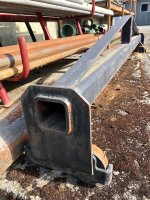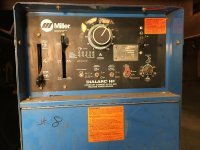Tractor Seabee
Elite Member
- Joined
- Oct 5, 2011
- Messages
- 3,896
- Tractor
- Kubota BX25
Brazing: There are several types. Basically it is a excellent process when (may be the only) joining dissimilar metals. Also used for the same materials like copper to copper and gold to gold when the alloys are different and application needs to be lower temp than the base materials. Some times mistakenly called solder like in "silver solder" when it slops into the lower temp materials. Also mistakenly called welding like in "bronze welding" and sometimes called "brass welding" . They are all forms of brazing just different filler metals. Look up silver solder on google; there are a myriad of alloys for a variety of reasons. The more silver the lower the application temp required and the stronger the joint is.
Bronze rod has always been my go to process for repairs to various grades of cast or malleable iron. It is almost as strong as the base material. I have even rejoined pieces like the base feet on industrial machinery. Seen a lot of it service already and never known to have one re-break. Lot less preheat required.
I have joined miles of copper piping with what's called in the trade phos-copper. It has no silver, just copper and phosphorus. The phosphorus lowers the application temp to below the melting point of copper. Joint is almost the same strength as the copper base. Used a lot in refrigeration and med gas piping except when joining to steel, brass or bronze. It leaves a heavy black oxide in the process, due to the high heat required, when oxygen is present. We purged the inside with nitrogen to prevent the oxide from contaminating the system as it is very abrasive.
Works great when joining stainless steel to other materials also, especially when arc is not available or not feasible for minor repairs.
I will leave gold and silver to the jewelers, even though I have a mini torch for that work. It comes in handy for other applications where fire is a potential problem.
Brazing 101, Ron
Bronze rod has always been my go to process for repairs to various grades of cast or malleable iron. It is almost as strong as the base material. I have even rejoined pieces like the base feet on industrial machinery. Seen a lot of it service already and never known to have one re-break. Lot less preheat required.
I have joined miles of copper piping with what's called in the trade phos-copper. It has no silver, just copper and phosphorus. The phosphorus lowers the application temp to below the melting point of copper. Joint is almost the same strength as the copper base. Used a lot in refrigeration and med gas piping except when joining to steel, brass or bronze. It leaves a heavy black oxide in the process, due to the high heat required, when oxygen is present. We purged the inside with nitrogen to prevent the oxide from contaminating the system as it is very abrasive.
Works great when joining stainless steel to other materials also, especially when arc is not available or not feasible for minor repairs.
I will leave gold and silver to the jewelers, even though I have a mini torch for that work. It comes in handy for other applications where fire is a potential problem.
Brazing 101, Ron



